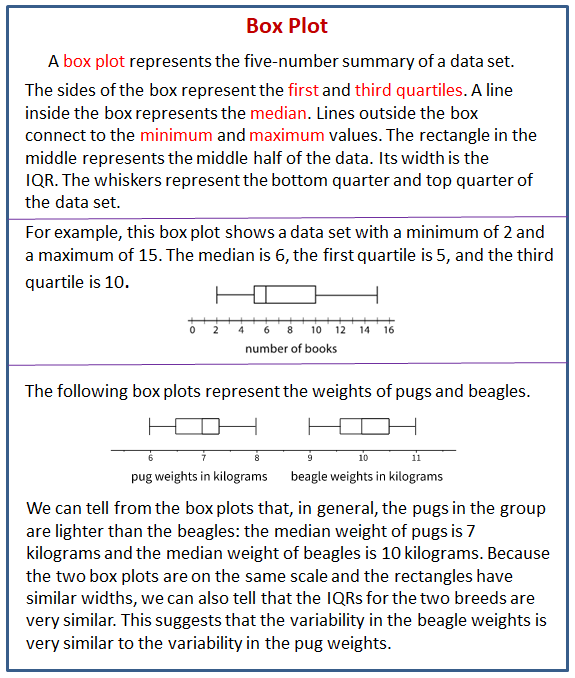Illustrative Mathematics Grade 6, Unit 8, Lesson 16: Box Plots
Learning Targets:
- I can use the five-number summary to draw a box plot.
- I know what information a box plot shows and how it is constructed.
Related Pages
Illustrative Math
Grade 6
Lesson 16: Box Plots
Let’s explore how box plots can help us summarize distributions.
Illustrative Math Unit 6.8, Lesson 16 (printable worksheets)
Lesson 16 Summary
The following diagram shows how to use the five-number summary to draw a box plot and know what information a box plot shows.

Lesson 16.1 Notice and Wonder: Puppy Weights
Here are the birth weights, in ounces, of all the puppies born at a kennel in the past month.
What do you notice and wonder about the distribution of the puppy weights?
Lesson 16.2 Human Box Plot
Your teacher will give you the data on the lengths of names of students in your class. Write the five-number summary by finding the data set’s minimum, Q1, Q2, Q3, and the maximum.
Pause for additional instructions from your teacher.
Lesson 16.3 Studying Blinks
Twenty people participated in a study about blinking. The number of times each person blinked while watching a video for one minute was recorded. The data values are shown here, in order from smallest to largest.
- a. Use the grid and axis to make a dot plot of this data set.
b. Find the median (Q2) and mark its location on the dot plot.
c. Find the first quartile (Q1) and the third quartile (Q3). Mark their locations on the dot plot.
d. What are the minimum and maximum values? - A box plot can be used to represent the five-number summary graphically. Let’s draw a box plot for the number-of-blinks data. On the grid, above the dot plot:
a. Draw a box that extends from the first quartile (Q1) to the third quartile (Q3). Label the quartiles.
b. At the median (Q2), draw a vertical line from the top of the box to the bottom of the box. Label the median. c. From the left side of the box (Q1), draw a horizontal line (a whisker) that extends to the minimum of the data set. On the right side of the box (Q3), draw a similar line that extends to the maximum of the data set. - You have now created a box plot to represent the number of blinks data. What fraction of the data values are represented by each of these elements of the box plot?
a. The left whisker
b. The box
c. The right whisker
Are you ready for more?
Suppose there were some errors in the data set: the smallest value should have been 6 instead of 3, and the largest value should have been 41 instead of 51. Determine if any part of the five-number summary would change. If you think so, describe how it would change. If not, explain how you know.
a. Minimum
b. First quartile (Q1)
c. Median (Q2)
d. Third quartile (Q3)
e. Maximum
-
Show Answers
The answers will depend on how many values are in the data set.
The data set has two values: 6 and 41
The minimum, Q1, Q2, Q3, and maximum are all changed.
The data set has three values.
The minimum, Q1, Q3, and maximum are changed. Q2 will not change
The data set has four values.
The minimum, Q1, Q3, and maximum are changed. Q2 will not change
The data set has five or more values.
The minimum and maximum are changed. Q1, Q2, Q3 will not change
Lesson 16 Practice Problems
- Each student in a class recorded how many books they read during the summer. Here is a box plot that summarizes their data.
a. What is the greatest number of books read by a student in this group?
b. What is the median number of books read by the students?
c. What is the interquartile range (IQR)? - Use this five-number summary to draw a box plot. All values are in seconds.
a. Minimum: 40
b. First quartile (Q1): 45
c. Median: 48
d. Third quartile (Q3): 50
e. Maximum: 60 - The table shows the number of hours per week that each of 13 seventh-grade students spent doing homework. Create a box plot to summarize the data.
- The table shows the number of hours per week that each of 13 seventh-grade students spent doing homework. Create a box plot to summarize the data.
- The box plot displays the data on the response times of 100 mice to seeing a flash of light. How many mice are represented by the rectangle between 0.5 and 1 second?
- Here is a dot plot that represents a data set. Explain why the mean of the data set is greater than its median.
- Jada earns money from babysitting, walking her neighbor’s dogs, and running errands for her aunt. Every four weeks, she combines her earnings and divides them into three equal parts—one for spending, one for saving, and one for donating to a charity. Jada donated $26.00 of her earnings from the past four weeks to charity.
How much could she have earned from each job? Make two lists of how much she could have earned from the three jobs during the past four weeks.
The Open Up Resources math curriculum is free to download from the Open Up Resources website and is also available from Illustrative Mathematics.
Try out our new and fun Fraction Concoction Game.
Add and subtract fractions to make exciting fraction concoctions following a recipe. There are four levels of difficulty: Easy, medium, hard and insane. Practice the basics of fraction addition and subtraction or challenge yourself with the insane level.

We welcome your feedback, comments and questions about this site or page. Please submit your feedback or enquiries via our Feedback page.